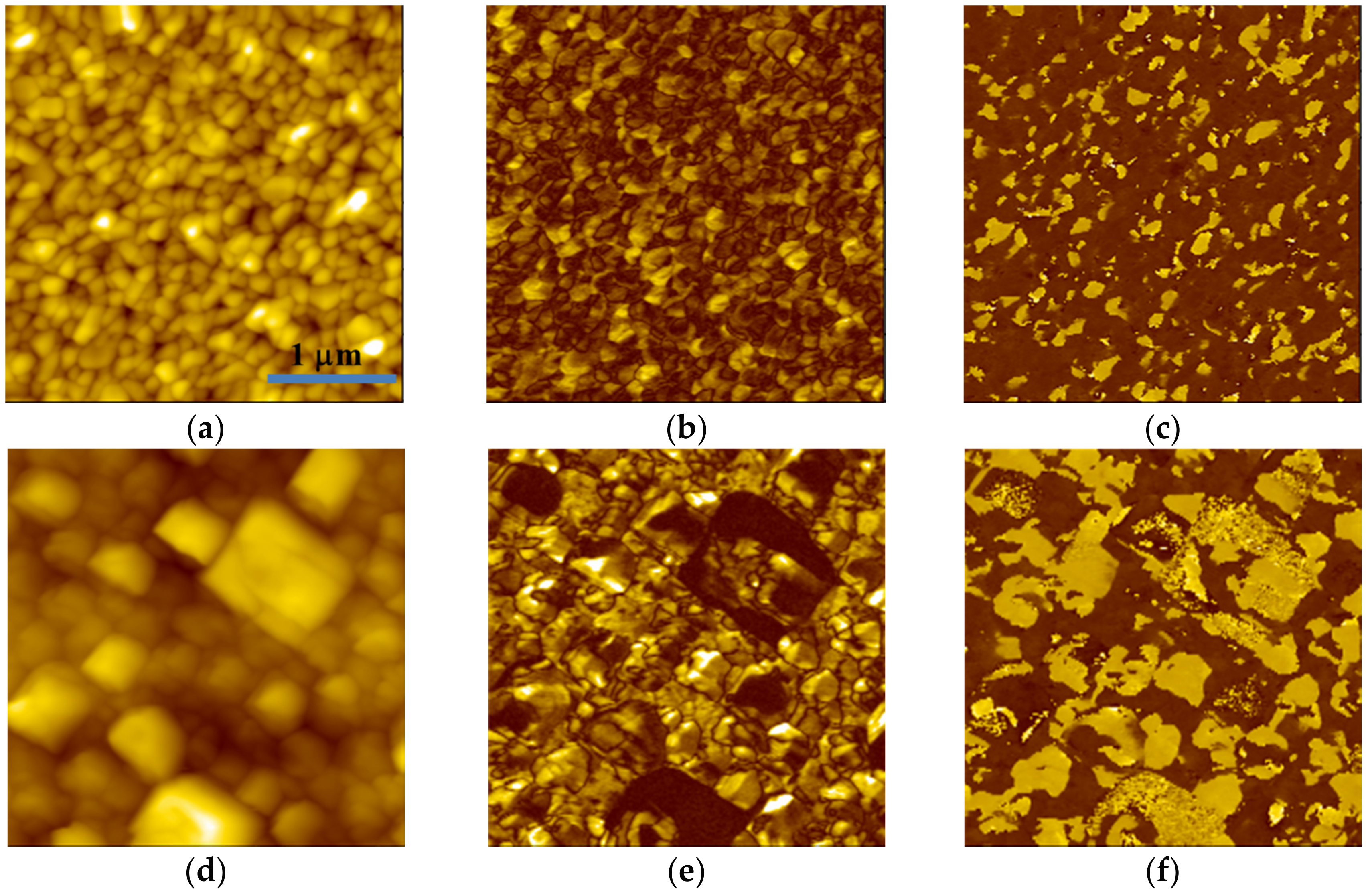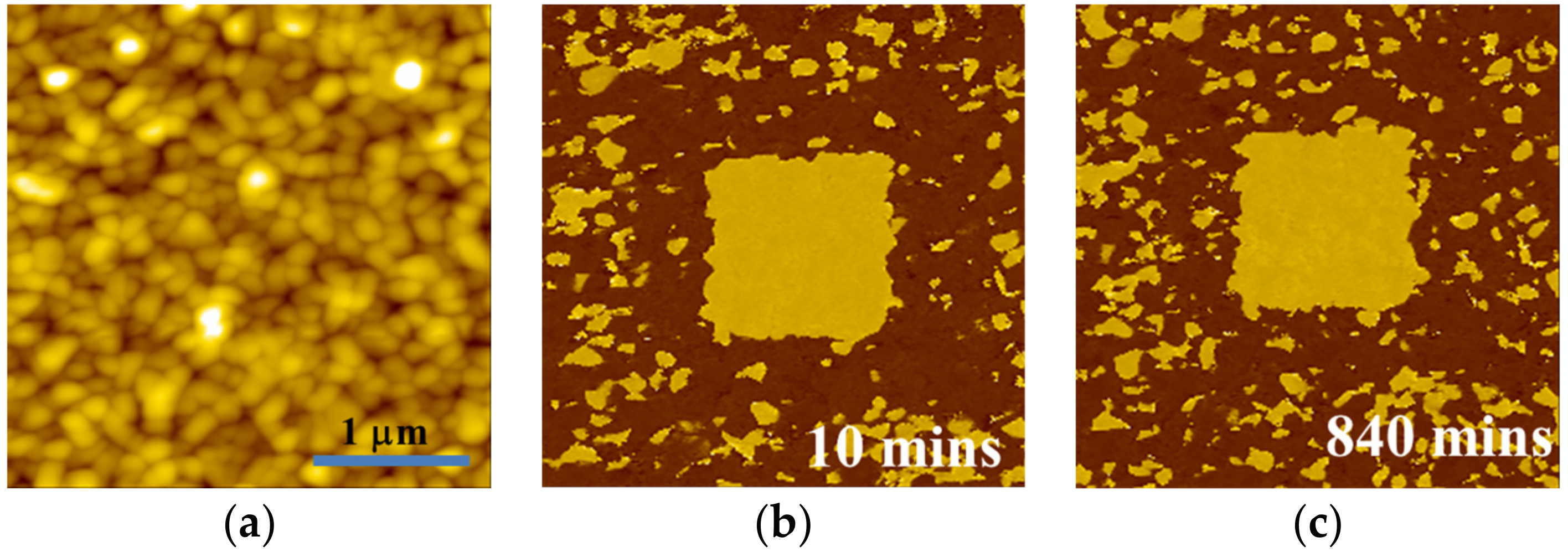Influence of Oxygen Pressure on the Domain Dynamics and Local Electrical Properties of BiFe0.95Mn0.05O3 Thin Films Studied by Piezoresponse Force Microscopy and Conductive Atomic Force Microscopy
Abstract
:1. Introduction
2. Materials and Methods
3. Results and Discussion
4. Conclusions
Supplementary Materials
Acknowledgments
Author Contributions
Conflicts of Interest
References
- Ramesh, R.; Spaldin, N.A. Multiferroics: Progress and prospects in thin films. Nat. Mater. 2007, 6, 21–29. [Google Scholar] [CrossRef] [PubMed]
- Seidel, J.; Martin, L.W.; He, Q.; Zhan, Q.; Chu, Y.H.; Rother, A.; Hawkridge, M.E.; Maksymovych, P.; Yu, P.; Gajek, M.; et al. Conduction at domain walls in oxide multiferroics. Nat. Mater. 2009, 8, 229–234. [Google Scholar] [CrossRef] [PubMed]
- Maksymovych, P.; Seidel, J.; Chu, Y.H.; Wu, P.P.; Baddorf, A.P.; Chen, L.Q.; Kalinin, S.V.; Ramesh, R. Dynamic conductivity of ferroelectric domain walls in BiFeO3. Nano Lett. 2011, 11, 1906–1912. [Google Scholar] [CrossRef] [PubMed]
- Laguta, V.V.; Morozovska, A.N.; Eliseev, E.A.; Raevski, I.P.; Raevskaya, S.I.; Sitalo, E.I.; Prosandeev, S.A.; Bellaiche, L. Room-temperature paramagnetoelectric effect in magnetoelectric multiferroics Pb(Fe1/2Nb1/2)O3 and its solid solution with PbTiO3. J. Mater. Sci. 2016, 51, 5330–5342. [Google Scholar] [CrossRef]
- Vaz, C.A.F. Electric field control of magnetism in multiferroic heterostructures. J. Phys. Condens. Matter 2012, 24, 333201. [Google Scholar] [CrossRef] [PubMed]
- Chen, Z.H.; Zou, X.; Ren, W.; You, L.; Huang, C.W.; Yang, Y.R.; Yang, P.; Wang, J.L.; Sritharan, T.; Bellaiche, L.; et al. Study of strain effect on in-plane polarization in epitaxial BiFeO3 thin films using planar electrodes. Phys. Rev. B 2012, 86, 235125. [Google Scholar] [CrossRef]
- Khist, V.V.; Eliseev, E.A.; Glinchuk, M.D.; Silibin, M.V.; Karpinsky, D.V.; Morozovska, A.N. Size effects of ferroelectric and magnetoelectric properties of semiellipsoidal bismuth ferrite nanoparticles. J. Alloys Compd. 2017, 714, 303–310. [Google Scholar] [CrossRef]
- Banerjee, P.; Franco, A. Rare earth and transition metal doped BiFeO3 ceramics: Structural, magnetic and dielectric characterization. J. Mater. Sci. Mater. Electron. 2016, 27, 6053–6059. [Google Scholar] [CrossRef]
- Price, N.W.; Johnson, R.D.; Saenrang, W.; Maccherozzi, F.; Dhesi, S.S.; Bombardi, A.; Chmiel, F.P.; Eom, C.B.; Radaelli, P.G. Coherent magnetoelastic domains in multiferroic BiFeO3 films. Phys. Rev. Lett. 2016, 117, 177601. [Google Scholar] [CrossRef] [PubMed]
- Wang, D.W.; Wang, M.L.; Liu, F.B.; Cui, Y.; Zhao, Q.L.; Sun, H.J.; Jin, H.B.; Cao, M.S. Sol–gel synthesis of Nd-doped BiFeO3 multiferroic and its characterization. Ceram. Int. 2015, 41, 8768–8772. [Google Scholar] [CrossRef]
- Sun, W.; Zhou, Z.; Luo, J.; Wang, K.; Li, J.F. Leakage current characteristics and Sm/Ti doping effect in BiFeO3 thin films on silicon wafers. J. Appl. Phys. 2017, 121, 064101. [Google Scholar] [CrossRef]
- Peng, X.P.; Liu, Y. Strain effects of the structural characteristics of ferroelectric transition in single-domain epitaxial BiFeO3 films. Chin. Phys. Lett. 2011, 28, 067702. [Google Scholar] [CrossRef]
- Sharma, S.; Tomar, M.; Kumar, A.; Puri, N.K.; Gupta, V. Effect of insertion of low leakage polar layer on leakage current and multiferroic properties of BiFeO3/BaTiO3 multilayer structure. RSC Adv. 2016, 6, 59150. [Google Scholar] [CrossRef]
- Barman, R.; Kaur, D. Leakage current behavior of BiFeO3/BiMnO3 multilayer fabricated by pulsed laser deposition. J. Alloys Compd. 2015, 644, 506–512. [Google Scholar] [CrossRef]
- Wang, W.; Zhu, Q.X.; Yang, M.M.; Zheng, R.K.; Li, X.M. Effects of oxygen pressure on the microstructural, ferroelectric and magnetic properties of BiFe0.95Mn0.05O3 thin films grown on Si substrates. J. Mater. Sci. Mater. Electron. 2014, 25, 1908–1914. [Google Scholar] [CrossRef]
- Wang, T.T.; Deng, H.M.; Cao, H.Y.; Zhou, W.L.; Weng, G.E.; Chen, S.Q.; Yang, P.X.; Chu, J.H. Structural, optical and magnetic modulation in Mn and Mg co-doped BiFeO3 films grown on Si substrates. Mater. Lett. 2017, 199, 116–119. [Google Scholar] [CrossRef]
- Jiang, B.; Selbach, S.M. Local and average structure of Mn- and La-substituted BiFeO3. J. Solid State Chem. 2017, 250, 75–82. [Google Scholar] [CrossRef]
- Zhang, N.; Wei, Q.H.; Qin, L.S.; Chen, D.; Chen, Z.; Niu, F.; Wang, J.Y.; Huang, Y.X. Crystal structure, magnetic and optical properties of Mn-doped BiFeO3 by hydrothermal synthesis. J. Nanosci. Nanotechnol. 2017, 17, 544–549. [Google Scholar] [CrossRef]
- Dhanalakshmi, B.; Rao, P.S.V.S.; Rao, B.P.; Kim, C.G. Enhanced ferromagnetic order in Mn doped BiFeO3–Ni0.5Zn0.5Fe2O4 multiferroic composites. J. Nanosci. Nanotechnol. 2016, 16, 11089–11093. [Google Scholar] [CrossRef]
- Singh, K.; Singh, S.K.; Kaur, D. Tunable multiferroic properties of Mn substituted BiFeO3 thin films. Ceram. Int. 2016, 42, 13432–13441. [Google Scholar] [CrossRef]
- Yu, H.Z.; Xu, K.Q.; Zhao, K.Y.; Li, G.R.; Zeng, H.R.; Wang, W.; Li, X.M. Local piezoresponse and electrical behavior of multiferroic BiFe0.95Mn0.05O3 epitaxial thin films deposited under different oxygen pressure. Ferroelectrics 2016, 492, 69–75. [Google Scholar] [CrossRef]
- Shur, V.Y.; Vaskina, E.M.; Pelegova, E.V.; Chuvakova, M.A.; Akhmatkhanov, A.R.; Kizko, O.V.; Ivanov, M.; Kholkin, A.L. Domain wall orientation and domain shape in KTiOPO4 crystals. Appl. Phys. Lett. 2016, 109, 132901. [Google Scholar] [CrossRef]
- Turygin, A.P.; Alikin, D.O.; Abramov, A.S.; Hreščak, J.; Walker, J.; Bencan, A.; Rojac, T.; Malic, B.; Kholkin, A.L.; Shur, V.Y. Characterization of domain structure and domain wall kinetics in lead-free Sr2+ doped K0.5Na0.5NbO3 piezoelectric ceramics by piezoresponse force microscopy. Ferroelectrics 2017, 508, 77–86. [Google Scholar] [CrossRef]
- Zhang, B.; Kutalek, P.; Knotek, P.; Hromadko, L.; Macak, J.M.; Wagner, T. Investigation of the resistive switching in AgxAsS2 layer by conductive AFM. Appl. Surf. Sci. 2016, 382, 336–340. [Google Scholar] [CrossRef]
- Bea, H.; Bibes, M.; Fusil, S.; Bouzehouane, K.; Jacquet, E.; Rode, K.; Bencok, P.; Barthelemy, A. Investigation on the origin of the magnetic moment of BiFeO3 thin films by advanced x-ray characterizations. Phys. Rev. B 2006, 74, 020101. [Google Scholar] [CrossRef]
- Yu, H.Z.; Cheng, H.G.; Xu, K.Q.; Zhao, K.Y.; Zeng, H.R.; Li, G.R. Local piezoresponse and thermal behavior of ferroelastic domains in multiferroic BiFeO3 thin films by scanning piezo-thermal microscopy. Chin. Phys. Lett. 2014, 31, 107701. [Google Scholar] [CrossRef]






© 2017 by the authors. Licensee MDPI, Basel, Switzerland. This article is an open access article distributed under the terms and conditions of the Creative Commons Attribution (CC BY) license (http://creativecommons.org/licenses/by/4.0/).
Share and Cite
Zhao, K.; Yu, H.; Zou, J.; Zeng, H.; Li, G.; Li, X. Influence of Oxygen Pressure on the Domain Dynamics and Local Electrical Properties of BiFe0.95Mn0.05O3 Thin Films Studied by Piezoresponse Force Microscopy and Conductive Atomic Force Microscopy. Materials 2017, 10, 1258. https://doi.org/10.3390/ma10111258
Zhao K, Yu H, Zou J, Zeng H, Li G, Li X. Influence of Oxygen Pressure on the Domain Dynamics and Local Electrical Properties of BiFe0.95Mn0.05O3 Thin Films Studied by Piezoresponse Force Microscopy and Conductive Atomic Force Microscopy. Materials. 2017; 10(11):1258. https://doi.org/10.3390/ma10111258
Chicago/Turabian StyleZhao, Kunyu, Huizhu Yu, Jian Zou, Huarong Zeng, Guorong Li, and Xiaomin Li. 2017. "Influence of Oxygen Pressure on the Domain Dynamics and Local Electrical Properties of BiFe0.95Mn0.05O3 Thin Films Studied by Piezoresponse Force Microscopy and Conductive Atomic Force Microscopy" Materials 10, no. 11: 1258. https://doi.org/10.3390/ma10111258



